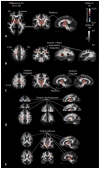Diffusion tensor imaging detects microstructural reorganization in the brain associated with chronic irritable bowel syndrome
- PMID: 23721972
- PMCID: PMC3758125
- DOI: 10.1016/j.pain.2013.04.010
Diffusion tensor imaging detects microstructural reorganization in the brain associated with chronic irritable bowel syndrome
Abstract
Irritable bowel syndrome (IBS) is a common gastrointestinal disorder characterized by recurring abdominal pain associated with alterations in bowel habits. We hypothesized that patients with chronic visceral pain associated with IBS may have microstructural differences in the brain compared with healthy control subjects (HCs), indicative of long-term neural reorganization of chronic pain pathways and regions associated with sensory integration. In the current study we performed population-based voxel-wise diffusion tensor imaging (DTI) comparisons and probabilistic tractography in a large sample of phenotyped patients with IBS (n=33) and in HCs (n=93). Patients had lower fractional anisotropy (FA) in thalamic regions, the basal ganglia (BG) and sensory/motor association/integration regions as well as higher FA in frontal lobe regions and the corpus callosum. In addition, patients had reduced mean diffusivity (MD) within the globus pallidus (GP) and higher MD in the thalamus, internal capsule, and coronal radiata projecting to sensory/motor regions, suggestive of differential changes in axon/dendritic density in these regions. Sex differences in FA and MD were also observed in the patients but not in HCs. Probabilistic tractography in patients confirmed a higher degree of connectivity between the thalamus and prefrontal cortex, as well as between the medial dorsal thalamic nuclei and anterior cingulate cortex, and a lower degree of connectivity between the GP and thalamus. Together, these results support the hypothesis that patients with chronically recurring visceral pain from IBS have long-term microstructural changes within the brain, particularly in regions associated with integration of sensory information and corticothalamic modulation.
Keywords: Chronic Pain; DTI; Diffusion Tensor Imaging; IBS; Irritable Bowel Syndrome; Reorganization.
Copyright © 2013 International Association for the Study of Pain. Published by Elsevier B.V. All rights reserved.
Conflict of interest statement
No authors have any conflicts of interest regarding the subject matter in this manuscript.
Figures












Comment in
-
Microstructural brain reorganization in chronic gastrointestinal disorders.Pain. 2013 Sep;154(9):1489-1490. doi: 10.1016/j.pain.2013.05.046. Epub 2013 Jun 3. Pain. 2013. PMID: 23742794 Free PMC article. No abstract available.
Similar articles
-
Unique Microstructural Changes in the Brain Associated with Urological Chronic Pelvic Pain Syndrome (UCPPS) Revealed by Diffusion Tensor MRI, Super-Resolution Track Density Imaging, and Statistical Parameter Mapping: A MAPP Network Neuroimaging Study.PLoS One. 2015 Oct 13;10(10):e0140250. doi: 10.1371/journal.pone.0140250. eCollection 2015. PLoS One. 2015. PMID: 26460744 Free PMC article.
-
White matter abnormalities in irritable bowel syndrome and relation to individual factors.Brain Res. 2011 May 25;1392:121-31. doi: 10.1016/j.brainres.2011.03.069. Epub 2011 Apr 3. Brain Res. 2011. PMID: 21466788
-
Disease-Related Microstructural Differences in the Brain in Women With Provoked Vestibulodynia.J Pain. 2018 May;19(5):528.e1-528.e15. doi: 10.1016/j.jpain.2017.12.269. Epub 2018 Jan 31. J Pain. 2018. PMID: 29391213 Free PMC article.
-
The role of diffusion tensor imaging and fractional anisotropy in the evaluation of patients with idiopathic normal pressure hydrocephalus: a literature review.Neurosurg Focus. 2016 Sep;41(3):E12. doi: 10.3171/2016.6.FOCUS16192. Neurosurg Focus. 2016. PMID: 27581308 Review.
-
Alterations of fractional anisotropy and white matter integrity in irritable bowel syndrome: a systematic review and meta-analysis of diffusion tensor imaging studies.Front Neurosci. 2024 Dec 2;18:1426218. doi: 10.3389/fnins.2024.1426218. eCollection 2024. Front Neurosci. 2024. PMID: 39687489 Free PMC article.
Cited by
-
Increased white matter diffusivity associated with phantom limb pain.Korean J Pain. 2019 Oct 1;32(4):271-279. doi: 10.3344/kjp.2019.32.4.271. Korean J Pain. 2019. PMID: 31569919 Free PMC article.
-
Neuroimaging Assessment of Pain.Neurotherapeutics. 2022 Sep;19(5):1467-1488. doi: 10.1007/s13311-022-01274-z. Epub 2022 Jul 28. Neurotherapeutics. 2022. PMID: 35902535 Free PMC article. Review.
-
Irritable Bowel Syndrome, Depression, and Neurodegeneration: A Bidirectional Communication from Gut to Brain.Nutrients. 2021 Aug 31;13(9):3061. doi: 10.3390/nu13093061. Nutrients. 2021. PMID: 34578939 Free PMC article. Review.
-
Neuroimaging chronic pain: what have we learned and where are we going?Future Neurol. 2014 Nov;9(6):615-626. doi: 10.2217/FNL.14.57. Future Neurol. 2014. PMID: 28163658 Free PMC article.
-
How do morphological alterations caused by chronic pain distribute across the brain? A meta-analytic co-alteration study.Neuroimage Clin. 2017 Dec 21;18:15-30. doi: 10.1016/j.nicl.2017.12.029. eCollection 2018. Neuroimage Clin. 2017. PMID: 30023166 Free PMC article.
References
-
- Arendt-Nielsen L, Graven-Nielsen T, Petrini L. In: Experimental Human Models and Assessment of Pain in Non-pain Conditions. Giamberardino MA, Jenseneditors TS, editors. Book Title|, Vol. Volume|. City|: Publisher|, Year|. p.^pp. Pages|.
-
- Attree EA, Dancey CP, Keeling D, Wilson C. Cognitive function in people with chronic illness: inflammatory bowel disease and irritable bowel syndrome. Appl Neuropsychol. 2003;10(2):96–104. - PubMed
Publication types
MeSH terms
Grants and funding
LinkOut - more resources
Full Text Sources
Other Literature Sources

